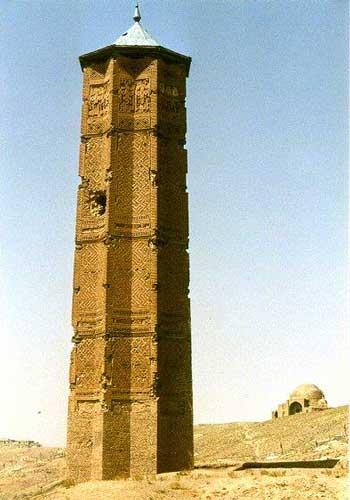Almost any job can be demanding at times, but if your work with the National Park Service involves cultural resources, you don't usually need to wear body armor. Earlier this year two NPS employees made a trip to Afghanistan to help document two rare and ancient brick towers, and the project offered plenty of challenges in addition to the need for body armor.
Dana Lockett and Paul Davidson are architects with the National Park Service’s Heritage Documentation Programs in Washington, D.C. This past July, the pair hauled their scanner, computers and personal gear to the Afghan province of Ghazni on a trip sponsored by the U.S. Department of State, Bureau of Educational and Cultural Affairs, Cultural Heritage Center.
The purpose of the visit, their first international high-definition laser scanning project, was to help the province preserve two rare brick towers covered with applied terracotta designs. The towers of Ghazni, known as “The Towers of Victory,” are among the last vestiges of the great Ghaznavid Empire, which ruled an area from the Caspian Sea to the Ganges Delta during the eleventh and twelfth centuries A.D.
Commissioned during the reigns of Masud III (A.D. 1099-1115) and Bahram Shah (A.D. 1118-1157), the flanged towers are built of fired mud brick faced with elaborate terracotta decoration which form geometric designs and Kufic inscriptions.
The towers rise more than 65 feet above the ground and at one time were even higher; the upper portion of the tower of Masud III was lost in an earthquake in 1902.
Today the towers are under threat from a number of sources. Exposure to rain and snow accelerates the deterioration of the intricate terracotta decoration while looting of mud bricks from the base of the towers threatens their integrity.
The towers are also adversely affected by the proximity of a road and are subject to periodic flooding. Limited conservation had taken place in the past, such as the installation of iron conical roofs in the 1960s, but continuous war and civil unrest over the past two centuries have prevented regular maintenance and encouraged further damage by looters.
Lockett and Davidson used high definition surveying – laser scanning – to capture the elaborate terracotta details of each façade as well as the brickwork of their exposed foundations. Their work provides baseline documentation for future conservation and preservation activities.
Both team members have extensive experience in the application of laser scanning to cultural resource documentation, but this project was anything but routine…or easy. The pair reflected on their experience after returning home.
"When the average daytime high is 100 degrees, you’re working at 7,500 feet above sea level, and you’re wearing full body armor while operating a terrestrial laser scanner designed to crash in said temperatures you have two options—either forge ahead with the 8 a.m. to 5 p.m. workday you are used to in Washington, D.C., all the while sizzling your melon and your very expensive laser scanner, or you go to work at 4 a.m., cram three days work into two, and drink a lot of water."
The correct choice, they noted, "is the second alternative."
“It was just too intense—for us and the equipment,” said Lockett. “It was cooler that early in the morning, only 75 degrees.”
“We really had problems with the scanner and our laptop computer when it got to the middle of the day,” Davidson said. “The scanner’s range of operation is between 32 and 104 degrees Fahrenheit, but it began to slow down above 90 degrees and the laptop just failed in the added harsh sunlight.”
This is also a case where getting there may not be half the fun.
Logistical support was complex, Lockett said. “It took us four days to reach the towers: three days of commercial flights to the U.S. Embassy in Kabul and an hour-long helicopter ride on the fourth day to Ghazni.”
The men were based at the Provincial Reconstruction Team (PRT) compound, which supports U.S. Navy, Army and Air Force members working with Polish forces, Department of State, USAID and the U.S. Army Corps of Engineers. Security and armored transportation were provided by the Texas Agribusiness Development Team (ADT). Yes, they had security nearby during their field work.
Lockett and Davidson were themselves part of the project documentation. Agnieszka Dolatowska, an archeologist and member of the Polish military, joined the men at the towers and photographed them as they completed their scans and photography.
“Our work was a curiosity for local Afghanis, who wandered close by,” Davidson said. “And before we came home we presented the field work to people at the PRT, including local and national media. We made presentations to architecture students and professors at Kabul University when we returned to the capital of Afghanistan."
The laser scan data will be processed along with high dynamic range pano-photography in the Heritage Documentation Programs office to produce existing-condition drawings of each panel comprising the towers’ elevations. The drawings, combined with Agnieszka Dolatowska's photographs, will lay the foundation for future conservation and preservation of the towers and also support efforts to mitigate adverse conditions and prevent looting.
“It was clear to us in our meetings with Ghazni officials that the people of Afghanistan want to preserve their cultural heritage," Lockett said, “and that was the most important reason for us to make this trip. They hope this project will promote greater preservation awareness of not only the 'Towers of Victory' but also of the many cultural sites throughout Afghanistan.”




Comments
Bravo!